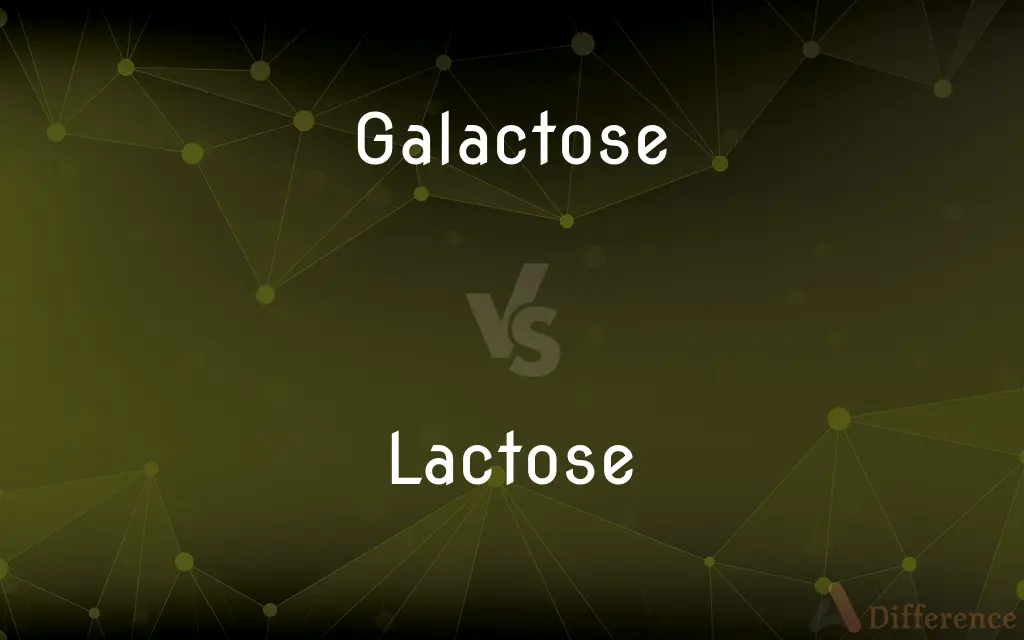Galactose vs. Lactose — What's the Difference?
By Urooj Arif & Maham Liaqat — Updated on March 27, 2024
Galactose is a monosaccharide sugar, essential in cellular processes, while lactose is a disaccharide, found in milk, composed of galactose and glucose.

Difference Between Galactose and Lactose
Table of Contents
ADVERTISEMENT
Key Differences
Galactose, a simple sugar, plays a crucial role in cellular energy and the formation of glycolipids and glycoproteins. It's a monosaccharide, meaning it consists of a single sugar molecule. On the other hand, lactose is a disaccharide, comprising two sugar molecules bonded together: glucose and galactose. Lactose is primarily found in milk and dairy products, serving as a major energy source for young mammals.
While galactose can be found in certain foods like dairy, avocados, and sugar beets, it's often consumed as part of lactose. Once ingested, lactose is broken down into glucose and galactose by the enzyme lactase, which is critical for its digestion. This contrasts with galactose's direct absorption and utilization in metabolic processes.
In terms of metabolic pathways, galactose is metabolized primarily in the liver through the Leloir pathway, converting it into glucose-1-phosphate, which then enters the energy-producing pathways. Lactose metabolism, however, starts in the digestive system, where it is hydrolyzed into its constituent sugars before they are individually metabolized.
The absorption and tolerance of galactose and lactose can vary among individuals. Some people lack the enzyme lactase, leading to lactose intolerance, where lactose remains undigested, causing discomfort. Galactosemia is a rare genetic disorder affecting galactose metabolism, highlighting the distinct metabolic challenges associated with these sugars.
Nutritionally, galactose is considered a part of the carbohydrate content in foods, contributing to calories but not found independently in high quantities in most diets. Lactose, however, is a significant carbohydrate in dairy products, affecting both the nutritional value and digestibility of these foods for certain populations.
ADVERTISEMENT
Comparison Chart
Type of Sugar
Monosaccharide
Disaccharide
Sources
Dairy, avocados, sugar beets
Milk and dairy products
Role in Diet
Part of other sugars, minor direct source
Major carbohydrate in dairy, energy source
Metabolic Process
Metabolized in liver via Leloir pathway
Hydrolyzed into glucose and galactose, then metabolized
Health Impact
Galactosemia affects its metabolism
Lactose intolerance due to lack of lactase
Compare with Definitions
Galactose
Can cause galactosemia if not properly metabolized.
Individuals with galactosemia must avoid galactose in their diet.
Lactose
A disaccharide sugar found in milk, composed of glucose and galactose.
Lactose gives milk its sweet taste.
Galactose
Essential for creating glycolipids and glycoproteins.
Galactose contributes to cellular membranes.
Lactose
Serves as a major energy source in young mammals.
Lactose in mother's milk supports infant growth.
Galactose
A monosaccharide sugar involved in human metabolism.
Galactose is metabolized in the liver.
Lactose
Contributes to the carbohydrate content of dairy products.
Lactose content varies among different types of dairy.
Galactose
Found in dairy, avocados, and sugar beets as part of lactose.
Consuming milk provides galactose through lactose digestion.
Lactose
Broken down by lactase enzyme in humans.
Lactase deficiency can lead to lactose intolerance.
Galactose
Absorbed and utilized directly in metabolic processes.
Galactose enters the Leloir pathway for energy production.
Lactose
Hydrolyzed into its constituent sugars before metabolism.
Digesting lactose yields glucose and galactose for energy.
Galactose
Galactose (, galacto- + -ose, "milk sugar") sometimes abbreviated Gal, is a monosaccharide sugar that is about as sweet as glucose, and about 65% as sweet as sucrose. It is an aldohexose and a C-4 epimer of glucose.
Lactose
Lactose is a disaccharide. It is a sugar composed of galactose and glucose subunits and has the molecular formula C12H22O11.
Galactose
A monosaccharide, C6H12O6, commonly occurring in lactose and in certain pectins, gums, and mucilages.
Lactose
A white crystalline disaccharide, C12H22O11, found in milk, that may be hydrolyzed to yield glucose and galactose. Refined lactose obtained from whey is used in infant foods, bakery products, confections, and pharmaceuticals as a diluent and excipient. Also called milk sugar.
Galactose
(carbohydrate) A monosaccharide found, along with lactose, in dairy products, and is synthesized by the body where it is found associated with glycolipids and glycoproteins.
Lactose
(carbohydrate) The disaccharide sugar of milk and dairy products, C12H22O11, a product of glucose and galactose used as a food and in medicinal compounds.
Galactose
A white, crystalline sugar, C6H12O6, isomeric with dextrose, obtained by the decomposition of milk sugar, and also from certain gums. When oxidized it forms mucic acid. Called also lactose (though it is not lactose proper).
Lactose
The main sugar present in milk, called also sugar of milk or milk sugar. When isolated pure it is obtained crystalline; it is separable from the whey by evaporation and crystallization. It is a disaccharide with the formula C12H22O11, being chemically 4-(
Galactose
A simple sugar found in lactose
Lactose
See Galactose.
Lactose
A sugar comprising one glucose molecule linked to a galactose molecule; occurs only in milk;
Cow's milk contains about 4.7% lactose
Common Curiosities
What is galactosemia?
Galactosemia is a genetic disorder that affects the body’s ability to metabolize galactose properly.
What is lactose?
Lactose is a disaccharide sugar found in milk, composed of one glucose and one galactose molecule.
Where is lactose found?
Lactose is primarily found in milk and dairy products.
How is galactose metabolized?
Galactose is metabolized in the liver through the Leloir pathway, converting it into glucose-1-phosphate.
Where is galactose found?
Galactose is found in dairy products, avocados, and sugar beets, typically as part of lactose.
What is galactose?
Galactose is a monosaccharide sugar, important for energy production and the synthesis of cellular components.
Is galactose a type of glucose?
No, galactose is a different type of sugar, although both are monosaccharides.
Can you have an intolerance to galactose?
Yes, in the form of galactosemia, although it’s a metabolic disorder rather than an intolerance.
How are galactose and lactose related?
Galactose is one of the two sugars that make up lactose, the other being glucose.
What is lactose intolerance?
Lactose intolerance is a condition where individuals cannot digest lactose properly due to a lack of lactase enzyme.
How do the bodies of young mammals utilize lactose?
Young mammals produce lactase enzyme to digest lactose, using the glucose and galactose for energy and growth.
How is lactose metabolized?
Lactose is hydrolyzed by the enzyme lactase into glucose and galactose, which are then individually metabolized.
Can everyone digest lactose?
No, some individuals lack the enzyme lactase and cannot digest lactose, leading to lactose intolerance.
Are galactose and lactose found in all dairy products?
Yes, most dairy products contain lactose, and therefore galactose as part of lactose, but the amounts can vary.
Is lactose bad for you?
Lactose is not inherently bad; however, individuals with lactose intolerance may experience discomfort after consuming it.
Share Your Discovery

Previous Comparison
Cooper vs. Hooper
Next Comparison
Average vs. MedianAuthor Spotlight
Written by
Urooj ArifUrooj is a skilled content writer at Ask Difference, known for her exceptional ability to simplify complex topics into engaging and informative content. With a passion for research and a flair for clear, concise writing, she consistently delivers articles that resonate with our diverse audience.
Co-written by
Maham Liaqat













































